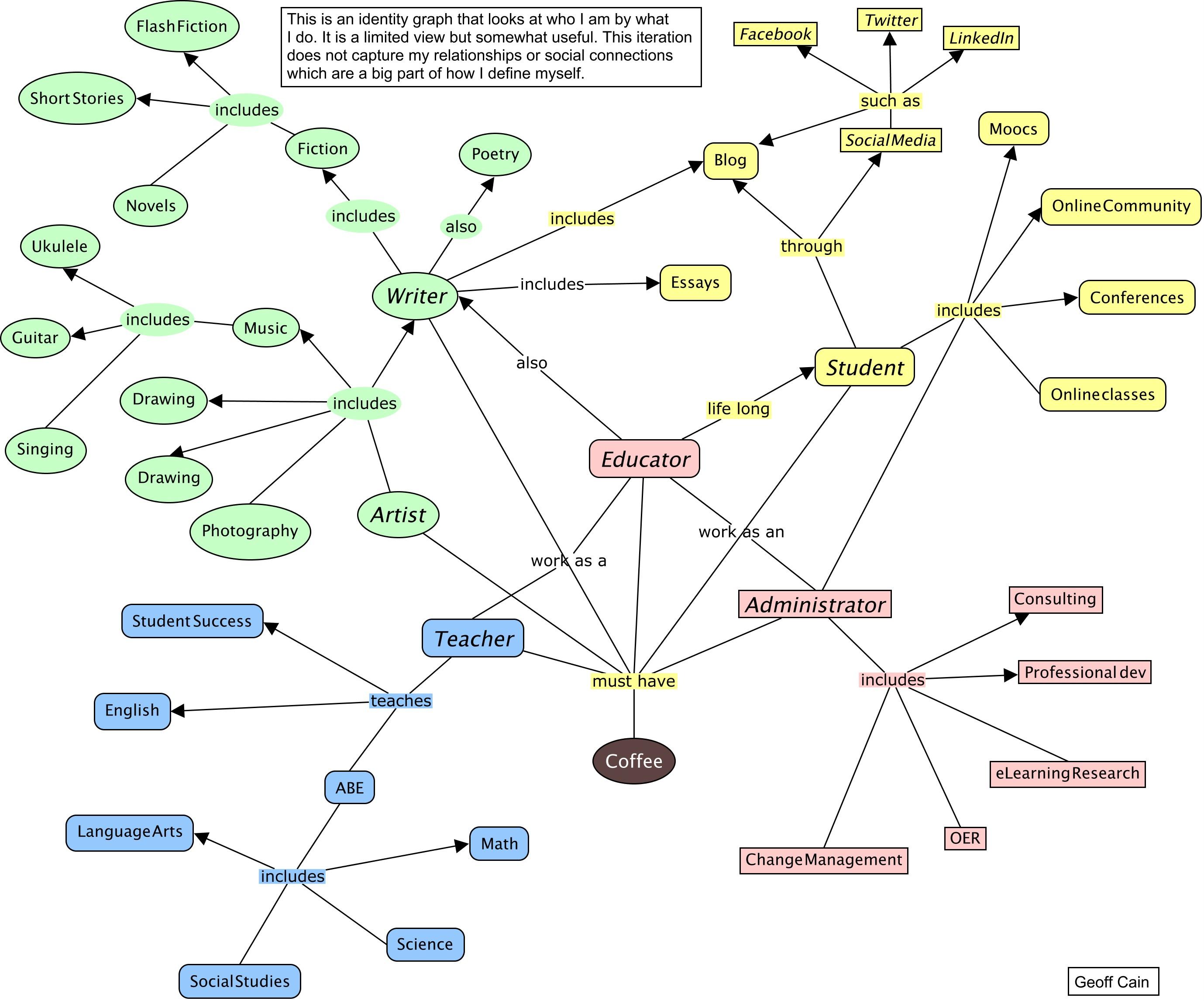 “The individual has always had to struggle to keep from being overwhelmed by the tribe. If you try it, you will be lonely often, and sometimes frightened. But no price is too high to pay for the privilege of owning yourself.” ―
“The individual has always had to struggle to keep from being overwhelmed by the tribe. If you try it, you will be lonely often, and sometimes frightened. But no price is too high to pay for the privilege of owning yourself.” ―
I am still reading the articles for our class, eLearning 3.0 and am not quite sure the value of thinking of my self as a decentered graph. Our assignment is:
Create an Identity Graph:
- We are expanding on the marketing definition of an identity graph. It can be anything you like, but with one stipulation: your graph should not contain a self-referential node titled ‘me’ or ‘self’ or anything similar
- Think of this graph as you defining your identity, not what some advertiser, recruiter or other third party might want you to define.
- Don’t worry about creating the whole identity graph – focusing on a single facet will be sufficient. And don’t post anything you’re not comfortable with sharing. It doesn’t have to be a real identity graph, just an identity graph, however you conceive it.
I took my first stab at this what-was-my-original-face-before-I-was-born-type exercise and thought about how much of my thinking about my identity depends so much on what I do. The graph captures what I do but does not capture my relationships with other people, the depth of my social media relationships, the magazines and books that I read, philosophers, religions, my favorite beers, food, cooking, sports, or travel – all of which go into who I am. I am sure Google knows this already.
What the graph does capture is the interconnectedness of the roles – the over-lap in all the things I do and how dependent they all are on coffee.
A number of Europeans that I have met are insulted by this idea: that what we do for a living has much to do with who we are essentially as people. Sometimes the work that people do have little to do with aspirations and more to do with luck or other circumstances. Many Americans define themselves by work. It is a very Puritanical/Capitalist thing to do.
And then there’s the Joke via Kurt Vonnegut:
“To be is to do”—Socrates.
“To do is to be”—Jean-Paul Sartre.
“Do be do be do”—Frank Sinatra.






You raised some good points about what is/isn’t included in your graph.
What tool did you use?
I used http://cmap.ihmc.us/ and exported as a jpg – I like CMap but it is getting a bit long in the tooth.
I like the reference to philosophers and Kurt Vonnegut’s Joke, which I haven’t come across before.
Does the value of thinking of ones self as a decentered graph lie in the potential shift from quantified to qualified self? Although I’m still trying to work out exactly what a qualified self might ‘look like’!
Hi Jenny – I loved YOUR post BTW.
Yes, I read that in Vonnegut somewhere but to be fair he was just recounting the fact that it was on a lot of bathroom walls in the 60’s and early 70’s 🙂 My favorite graffito of that time though has to be “there is no gravity” written upside down. I am not sure what the shift to a “qualified self” means for me since I am not sure if I engaged too much in quantifying myself – but I sure as heck know that others have (e.g. Google, Facebook, etc.). But this is beginning to sound like a second or third espresso question. I am completely with you that this is a new way of thinking about “self” – although Indra’s Net is essentially decentered.
Pingback: The Quantified, Qualified and Connected Self – Jenny Connected
Pingback: #EL30 – On the Narrative Identity, and our Data Obsession – Engram Seeker